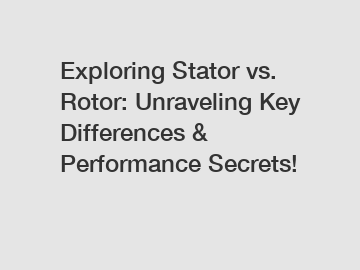Exploring Stator vs. Rotor: Unraveling Key Differences & Performance Secrets!
When it comes to understanding the inner workings of electric motors, we often hear the terms "stator" and "rotor," but what exactly are they, and how do they contribute to the performance of these essential machines? In this blog, we dive deep into the world of stators and rotors, uncovering their key differences, and revealing some performance secrets that engineers and enthusiasts will find fascinating. So, let's roll up our sleeves and embark on this insightful journey together!
Understanding the Stator and Rotor.
To grasp the unique roles played by the stator and rotor, we must first understand their fundamental definitions. The stator is the stationary component of an electric motor, while the rotor is the moving part. In simpler terms, the stator serves as the foundation, housing the windings that create the magnetic fields necessary for motor operation. The rotor, on the other hand, is designed to rotate within the stator's magnetic field, enabling the conversion of electrical energy into mechanical energy.

Key Differences Between the Stator and Rotor.
1. Design and Construction: While the stator is typically made of a series of laminations, arranged in a concentric manner to form a cylindrical shape, the rotor is built with conductive bars or wires, often housed in an iron core. This design variation directly affects their functionality and performance characteristics.
2. Mobility: As mentioned earlier, the stator remains stationary during motor operation, while the rotor rotates. This distinction is crucial as it influences their roles in converting electrical energy to mechanical energy.
3. Power Generation: The stator acts as a source of the stationary magnetic field, which is essential for the generation of torque. On the other hand, the rotor experiences varying magnetic fields as it rotates within the stator, enabling the conversion of electrical power into mechanical motion.
4. Induced Voltage: Since the stator is responsible for generating the magnetic field, it also induces voltage within the rotor. This induced voltage, known as the electromotive force (EMF), plays a vital role in maintaining continuous rotational movement, controlling speed, and powering auxiliary components.
Performance Secrets Unveiled.
1. Efficiency: The efficiency of an electric motor relies heavily on both the stator and rotor. The design and construction of these components significantly impact the motor's performance. For instance, the stator winding quality and geometry determine the level of energy losses, while the rotor's core material and design affect its ability to conduct the induced electrical currents efficiently.
2. Torque and Speed Control: By altering the magnetic fields produced by the stator windings, engineers can effectively control the torque and speed of electric motors. This adjustability ensures optimal performance across a wide range of applications, making electric motors adaptable to various tasks.
3. Heat Management: The stator and rotor designs play significant roles in managing heat generated during motor operation. Adequate ventilation and cooling systems ensure that the stator windings and rotor conductors do not overheat, thus safeguarding the motor's overall performance and lifespan.
4. Noise Reduction: Noise production is another aspect influenced by the stator and rotor designs. By utilizing superior materials, optimizing magnet placement, and incorporating advanced noise suppression techniques, engineers can significantly reduce noise levels, improving overall user experience and increasing the motor's lifespan.
Conclusion.
In conclusion, understanding the stator and rotor, along with their key differences, is paramount for comprehending the inner workings and performance characteristics of electric motors. Their unique designs and functions significantly influence factors like efficiency, torque, speed control, heat management, and noise reduction. By continuously enhancing these components, engineers strive to unlock the full potential of electric motors, making them versatile and reliable power sources across a wide range of applications. Remember, the next time you encounter an electric motor, you'll have a deeper appreciation for the intricacies of its stator and rotor, and the role they play in transforming electrical energy into mechanical power.
If you are looking for more details, kindly visit custom stamped stator and rotor cores, lamination welding, stator lamination welding.


